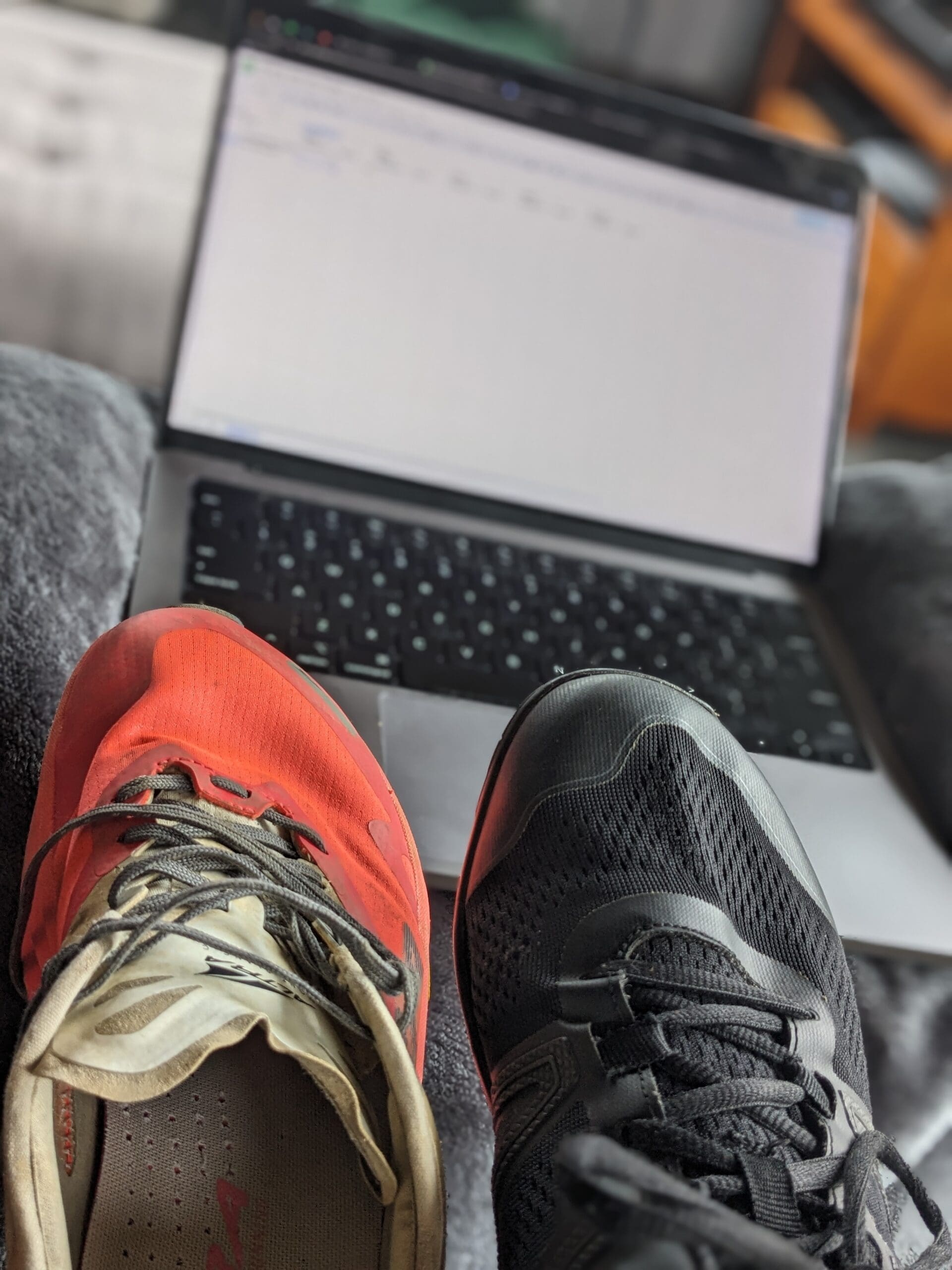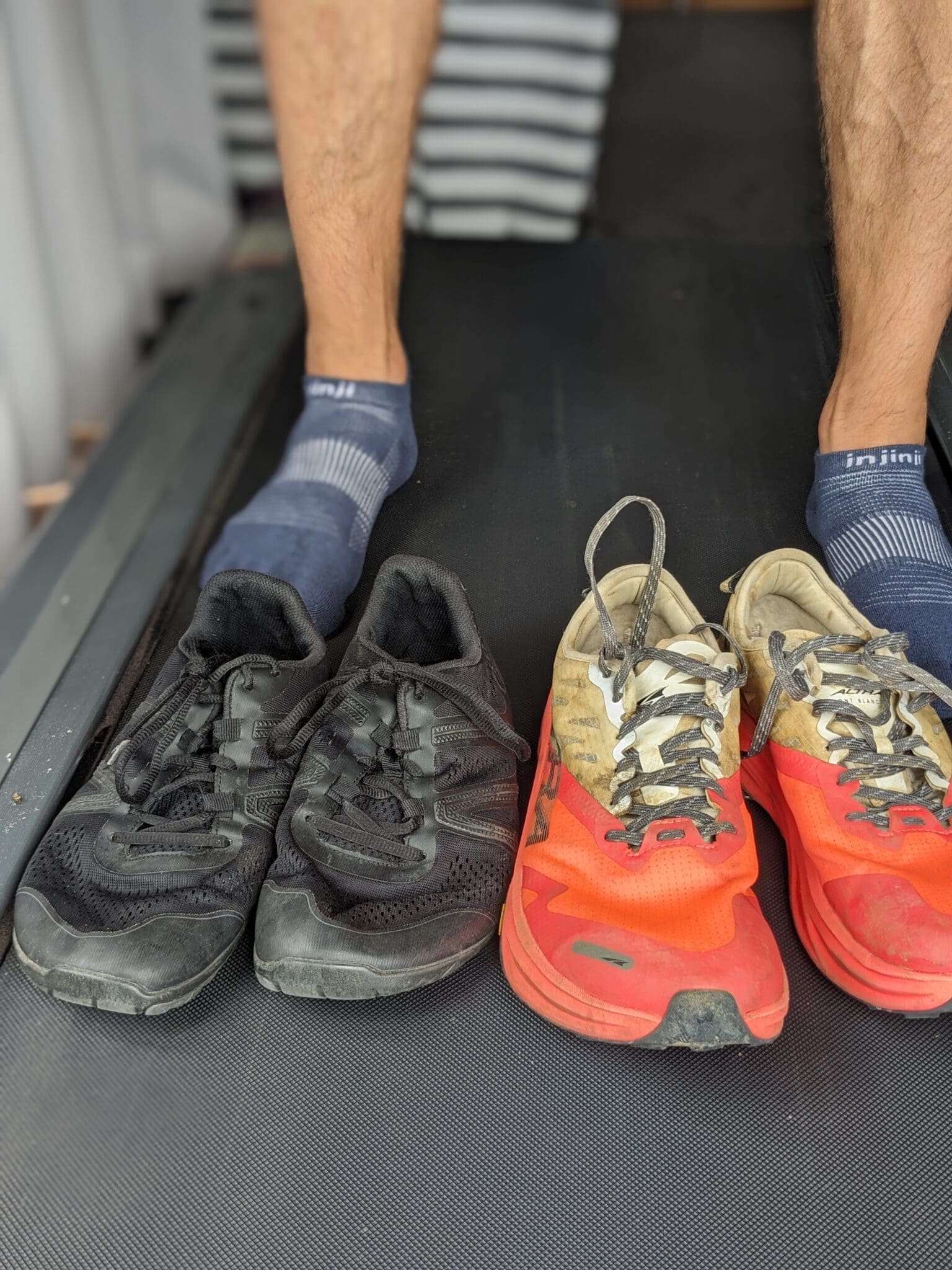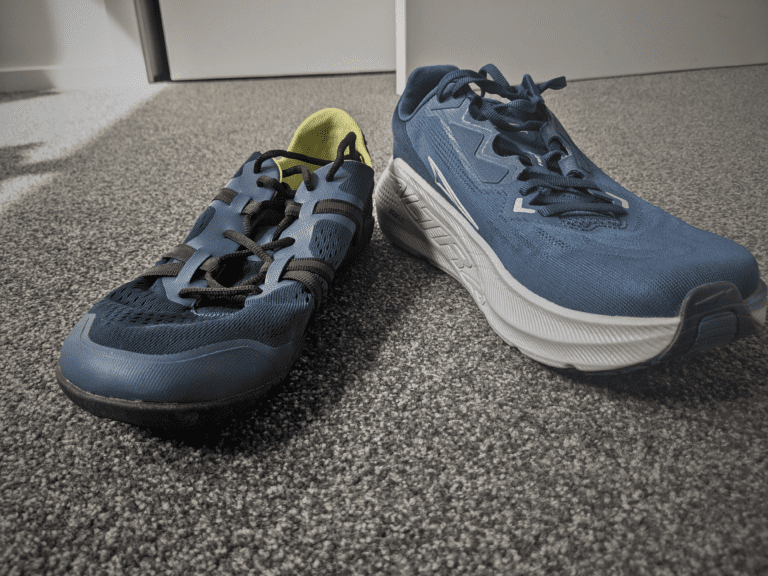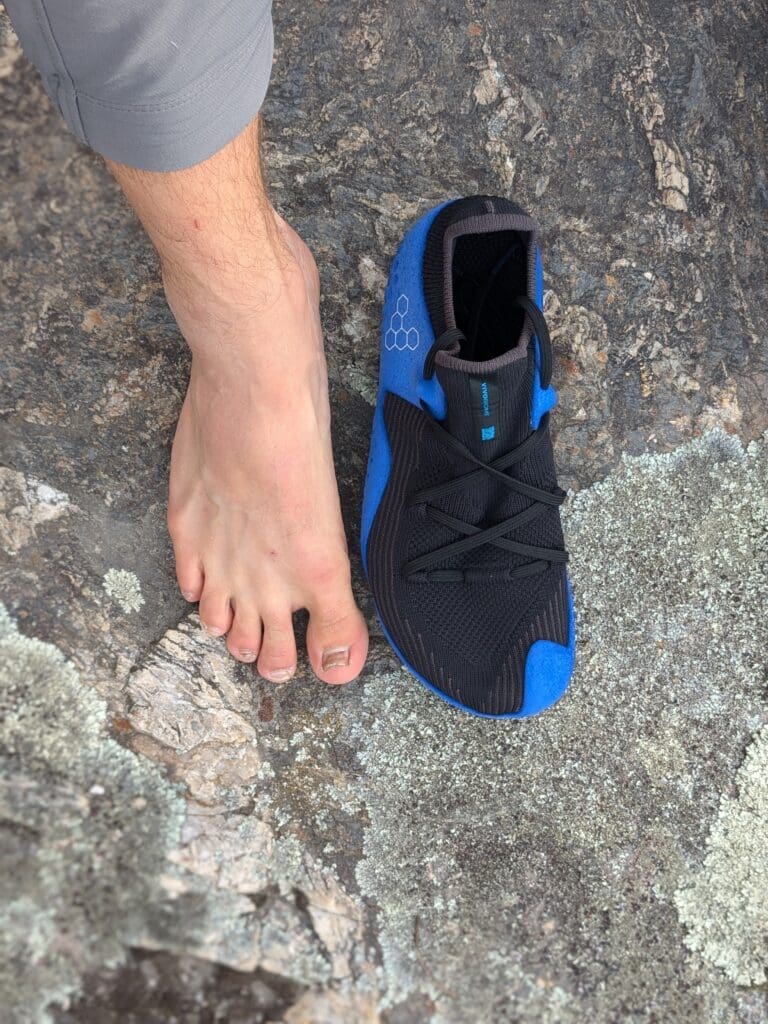If you hang around the barefoot community, you’ll see a question pop up occasionally.
“If barefoot is best, why aren’t pro athletes running barefoot”?
There are many aspects to the question. Sponsorship, training distances, different gait patterns, but often what the questioner is getting at is:
“Is barefoot faster?”
And that’s the question I’m out to answer today!
I put in some heavy treadmill sessions, both in minimal and super shoes, and analyzed my performance in each.
And the answer was easy to see.
But first…..
I’ve been running in what some would call “barefoot shoes” for a while now.
I originally did so because I was convinced it was “natural” or how we, as evolved humans, were designed to run.
And while I still think there’s some truth to that, my views have changed slightly.
Which minimal running shoe is for you?
Take a quick 5-question quiz to identify the perfect minimal running shoe for your feet! You'll get both road and trail options based on your answers!
Shoes as tools
Shoes are merely tools that we use to get the job done. That’s why rain boots are great for keeping your feet dry, but not when hiking long distances. And the same applies to different types of running shoes.
If our goals are running speed, endurance, and longevity, what would you think the logical shoe choice would be?
Nike running shoes?
I could possibly see the argument for speed, but in terms of endurance and longevity, high-cushioned, highly structured shoes should really be questioned.
Over the long term, shoes from brands like Nike tend to reduce activation in the foot and lower leg and cause a runner to land heavier with each footstep.
If we now compare that with a minimal shoe offering, we see an increase in the lower leg and foot activation and less impact forces due to the muscular activation of the lower leg.
Logically, we could come to a conclusion – if we work out to stress the body and ultimately recover stronger, we should opt for minimal shoes. And then we’d use cushioned shoes if we want to unload stress from our legs.
This means that minimal shoes could actually make us faster over the long term. And cushion shoes could make us fast, but only in the short term.
And this is exactly what my data shows!
The shoes
Altra Mont Blanc Carbon—After reviewing the Altra Mont Blanc Carbon recently, I finally had a super shoe for interesting tests like this! Even though this is a trail-focused shoe, it still has a carbon plate and a higher stack height.
Xero Shoes HFS – I put the Mont Blanc Carbon up against the Xero Shoes HFS, a super minimal 5.5mm stack height shoe. As near to barefoot as you’ll get with a little proteciton underfoot.

The tests I performed
To make these tests as fair as possible, I used a treadmill at set speeds and analyzed my heart rate using each shoe.
This technically doesn’t test how “fast” a shoe is, but it gives us an indication of how hard I was working at the given speeds.
- 10km per hour – 5 mins
- 12km per hour – 5 mins
- 14km per hour – 5 mins
- 16km per hour – 5 mins
- 18km per hour – 3 mins (I couldn’t sustain this pace for 5 mins 😀)
Before each test, I ensured my HR had dropped back down below 100 before starting the next test, and also walked at 6km/h for 1 minute before starting the interval.
I also rotated between shoes, putting the Mont Blanc Carbon 2nd for each speed to ensure this was as controlled as possible.
And lastly, all heart rate measurements were taken on a Coros Pace 2, which could be argued is not 100% reliable. But as all values were taken on this watch, there is some consistency within the test.

Show me the Results!
The two graphs above clearly show that I was working harder when running in the Xero Shoes HFS.
The only time this wasn’t exactly true was at 18km/h, but this can easily be explained away because I was on the limit. A heart rate of 189 is likely impossible for me, so I would happily ignore these data points.
So, with these results, I’d be confident in saying that I run more efficiently in the Altra Mont Blanc Carbon.
But does efficiency tell the whole story?
To be faster in the future, I believe we need to take a mixed approach to minimal shoes and super shoes.
I’m convinced I could gain an extra few percent in speed in a super shoe, but what are the drawbacks of using such a shoe too often?
When we run in higher-cushioned shoes, we tend to land with more impact force than we do with minimal shoes or 100% barefoot, as I’ve proven in past posts with impact force measurements.
This is likely due to the increased proprioceptive feedback that we receive when running closer to the ground. Once our body and brain identifies the harder surface, it subtly changes our running gait to reduce impact forces.
That explains why our feet, ankles, and calves work harder in minimal shoes and often ache when transitioning to barefoot running.
So, using cushioned shoes will make running easier, right?
That statement is somewhat true, but easier doesn’t mean better. The heavier impact forces have to go somewhere, and the foam does not dissipate all that force, meaning your knees, hips, and back take a hard hit.
Furthermore, by unloading the lower legs and feet more, these structures will weaken over time, making you more susceptible to injuries in these areas.
And for all those reasons, I believe barefoot training is a key tool in your running training plan!
From the cadence measurements, it’s easy to see how I adjusted when running in minimal shoes, especially at higher speeds, which generally equate to lower impact forces.
I don’t actively make these changes. They occur only due to the minimal nature of the shoes and feedback I’m getting through more ground feel.
Ultimately, the question itself, “What is the fastest shoe?” is wrong.
Instead, we should focus on tools and processes that make us faster. And we can do that with a two-pronged approach.
- Integrate a barefoot/minimal shoe routine into your practice.
Initially this will only be walking around barefoot, but you can build from there. Check out my course if you’d like to learn more about transitioning to minimal running!
- Use super shoes only when appropriate.
That mostly means in a race situation only due to the speed increase you may see. Yes, it’s wise to get some miles in before a race so you’re comfortable in a shoe, but they shouldn’t be your only training tool. The drawbacks of using super shoes during training could outweigh the benefits on race day.




Hi Nick,
Super interesting stuff. What´s your guess regarding “which shoe is faster”, for example for a road half marathon vs. trail marathon vs. 100 mile run in the mountains.
By the way, I hope you like your new home and all is well!
Best wishes from Austria
Wolfgang
Good question Wolfgang.
I would guess it’s highly dependent on the fitness of the individual. i.e. if you’re well adapted to running super long distances, you’d be better suited to a “super shoe” in those conditions.
But is it worth the risk in a 100 miler? I don’t think so.
At the same time, we know that minimal shoes put more strain through he lower legs, feet and ankles, so there’s a drawback there too.
Is there a halfway house? Maybe? Altra Superior?
In the end, it’s going to come down to how well your body is adapted to the conditions and the shoes you’re running in. And for me, that means more minimal, but taking into account that I become sloppy over the long distance, I want to avoid bruising of the heels and forefoot, so I’d opt for a little more cushion and protection. (Altra Superior, Xero Shoes Scrambler Low).
For the shorter distances, I’d just risk the potential damage and move fast! 🙂
Love the thinking. Thanks!
Informative post as always!
That’s also a good question from Wolfgang and often makes me wonder too. I would say that on long ultras the comfort of the shoe outweighs any wheight penalty and super shoe technologies. For example let’s say you are running a road half marathon under 2 hours, you may get away with a certain discomfort from a narrow carbon super shoe, which is “faster” than your dailytrainer. However running 15+ hours with blisters after the first few hours is out of the question. Of course if a carbon racer super shoe works for you on really long runs, then no problem. The tricky part for ultras in my eye is to find the most comfortable shoe that fits your foot shape and is optimal for your running gait. A shoe that is comfortable for 2-3 hours of running, might not be after 10 hours. Picking a shoe for ultras you also have take into account what type of terrain are you going to run, if it’s rocky technical, muddy of dry gravel. On road racing the question is much more simple.
Cheers and have fun running!
Completely agree. And I love the nuance Wolfgang added.
It’s completely true. My decision would be different on a 100-miler. I’d choose comfort (meaning less injury/blister risk, not exactly the feeling of shoe) over speed.
What I’m yet to work out is if I’m well trained in minimal shoes, is it “safer” to run in minimal shoes over the long distance due to the reduced impact forces, or will that still put too much strain on the feet and lower legs.
From experience, on a very tough 50km, my legs were beat up. I would have loved to have done the exact same in mildly cushioned shoes for a comparison.
Conversely, I ran/walked +700km in 16 days, all in minimal shoes. Albeit at a much slower speed.
There are many variables to take into account! 🙂
I love this kind of conundrum though!
I’m a short-to-middle distance triathlete with close to 10k on Merrell Vapor Glove 4 and couple thousand more on the Vapor Glove 6 – would love to read a review of yours on them. The 4s are my favorite as there’s a shorter stack and keep my feet cooler for longer, but the 6s have found a place when occasionally running trails or slower runs where cadence is lower than usual. For the past 6mo I have been doing a lot of low aerobic training and the 6s became my daily trainer.
Now, I will be speeding up and racing again, and I was not considering any other shoes until I read some of your articles that got me thinking I should consider giving my lower legs some rest, so I’m eyeing a pair of Altra Escalante Race 2 to rotate with the VG 4. Do you have any thoughts on what the rotation should look like? Or is this a stupid idea since I’m already used to running in minimalistic shoes?
Thank you, Nick!
Thanks for the message! I think you’re on the right track.
First, I do have a review on the Vapor glove 6. 🙂 if you use the search icon on the site, you’ll find it.
As for using an Escalante Racer. If you want it optimize for pure speed, this will work. You can even use a super shoe as mentioned in this article and I’m sure you’ll be even faster. But there are always trade offs.
Shoes are tools to do the job.
Cushioned shoes allow you move faster, but cause greater stresses higher up the chain in most cases. (Hips, back, knees)
Minimals shoes allow for better proprioceptive feedback from the ground, but cause greater stress in the feet and lower legs.
Generally. I feel minimal shoes are a great training tool, and cushioned shoes are great speed/recovery tools. But obviously there’s nuance to that theory too.
I think the Escalante Racer is a perfect option for you to try a cushioned shoe that still has the beneficial features of a foot shaped shoe. I’d suggest you test it out. See if you can run faster times, but stick to barefoot shoes for much of your training.